
: : : Percussions : : Cuba : Instruments
The congas
- : : Presentation
- : : Traditional hitting Techniques
- : : Basic Principle of alternating hits
- : : Basic patterns with audio demos
Presentation
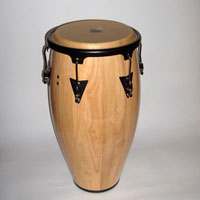
The congas are an adaptation of hand drums (played with the fingers) with cylindrical shape (with shell in hollowed tree trunk) coming from Congo (named "Ngoma" in Bantu). These are the rebellious slaves exiled from Africa to Cuba who invented by converting French wine barrels, by mounting skins on them. The technique of drum shell with solid oak slats bent in the heat of fire and with iron-bound, is remained, but the African tension system with rope or nails was improved, by using a steel hoop and tension rods (invented by the Cuban Gonzalo Vergara in the 1950's). To expand the range of tones, very elongated barrels were also created (thereby closer to their African "parents"). The skin is still a cowhide but oiled to make it waterproof and therefore insensitive to changes in humidity of the air, which affect the tension of the skin.
Today congas slats are usually carved to give the rounded shape and then glued, sanded and lacquered. Cheap versions with plastic shell also exist but their sound is pretty poor and ugly. The steel parts can be painted (cheaper but it doesn't affect the sound very much), chromed (strongest) or even gold plated (luxury models, for the scene).
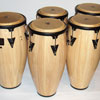
The "tumba" means a low and large conga (about 12 inches diameter hoop (1 inch = 2, 54 cm)).
 The "conga" means a medium drum (about 11 inches in diameter skin), the "quinto", a high pitched drum (about 10 inches). Traditionally played in pairs, as in Africa, many contemporary virtuosos play on 4 or 5 congas (like Giovanni Hidalgo , Ray Barretto , Raul Rekow , Miguel "Anga" Diaz , to name a few (see my lesson: "The playing with 4 or 5 congas")). The congas can be played sitting or standing with special stands that elevate them.
The "conga" means a medium drum (about 11 inches in diameter skin), the "quinto", a high pitched drum (about 10 inches). Traditionally played in pairs, as in Africa, many contemporary virtuosos play on 4 or 5 congas (like Giovanni Hidalgo , Ray Barretto , Raul Rekow , Miguel "Anga" Diaz , to name a few (see my lesson: "The playing with 4 or 5 congas")). The congas can be played sitting or standing with special stands that elevate them.
At least one conga (usually the higher pitched) is always placed between the legs, when playing seated. It can be very slightly forward tilted, leaning on the crotch, to improve its resonance (you can also enclose it with your legs, to prevent it from falling forward).

Traditional hitting techniques: (notation key)
-
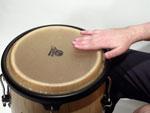 open tone
open tone
: : click to enlarge : : a: low resonant stroke or "tonic" or "open tone" (halfway between the center and the rim, hand flat, stroke with joint fingers together taut and firm, the palm in the air, to improve the bounce); -
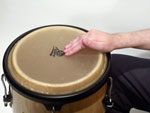 slap
slap
: : click to enlarge : : a': "slap" (energetic stroke on rim with the palm and projection of the fingertips on the skin, supple and relaxed, close to the edge, to obtain a dryer note and higher tone. You can also complete the gesture by "pressing" the fingers against the skin to "dry" the sound even more); -
 bass or palm
bass or palm
: : click to enlarge : : b: hit of the palm alone on the center of the skin (or "bass tone" ), fingers remaining in contact with the skin (low, soft and muffled sound); -
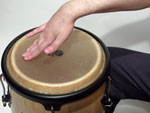 muffled fingers
muffled fingers
: : click to enlarge : : c: hit of the fingers alone, the palm being stuck on the center of the skin to muffle (dry, high and soft sound, alternating with the previous one, in a swinging or "rocking" motion); -
 rim
rim
: : click to enlarge : : d: hit on the rim , just at the joint between the shell and the skin, for a maximum of high overtones while maintaining resonance (hitting with fingers, palm in the air); - e: same as "a" but for low conga;
- A, A ', B, C, D, E: same as above but for the right hand;
- -: rest.
Basic principle of alternating strokes:
One hand makes the strokes with arm movement and passages (A, A ', E), generally the right (implies a position of the low conga to the right of the right leg) and the other is "stuck" on the central conga filling the rests by a continuous flow of alternating soft strokes, palm and fingers (b and c). Note that when the palm is rested, it usually precedes a slap to "dry" it (stroke A'), and when it is lifted, a minimal contact with the fingertips (or even just the middle finger) allows the resonance of the drum (stroke A ).
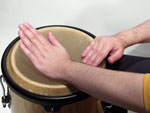 muffled slap with fingers up and palm rested
muffled slap with fingers up and palm rested
: : click to enlarge : :
 open tone with palm up
open tone with palm up
: : click to enlarge : :

Basic patterns: (100)
Click on a pattern to hear a demo played by Marc de Douvan (right-click and select "save target as" to download the file).
- 1: the single stroke roll (1 stroke per hand):
- AaAa, ou A'a'A'a', BbBb, CcCc, DdDd, A'cA'c, AbAb, EaEa, A'a'Aa, AaDd, A'aAa, A'aAaEaAa, AbEb, AdDd, EdDd, AdDdEdDd, AdDaDd, EdDaDd, AdDaDa, Ea'EaA'a, A'a'A- , A'a'E- , A'a'A- A'a'E- , A'a'- A'a'- , A'a'- - , A'a'- Aa- , A'a- A'a- , AaAaA- - -, AaAaA- , AaAa- - , A'a'A'a'- - AaAa- - , Aa'A'a'- - , AaA'a'- - , AaAaDdDd, AaAaAaDdDdDd, DdDdAa, AaAdDd, A'a'Ea'- - , EaE- aEa- , EaA'- aEa- A'aE- aA'a- , A'a'A'-a'-, A'a'A'- a'- A'- a'- - - , A'a'A'a'A'- a'- , Ea'A'- a'- , EaE- a- , etc.
- 2: the double stroke roll, on the basis of snare drum roll (2 strokes per hand):
- BCbcBCbc... Other binary rolls: bcAAbcAA, bcAAbcEE, AAaaAAaa, EEaaEEaa, BCbcEEbcBCaa, etc.
- 3: ternary roll (2 strokes with one hand, one stroke with the other):
- AbcAbc ou A'cbA'cb, AbcEbc, AbcAbcEbc, AbcA'cb, bAAbAA, bAAbEE, aEEaEE, aEaaEa, aEEaEa, A'cAAbc, A'cAbc, etc.
- 4: 4 beats filling:
- A'cbcA'cbc or AbcbAbcb, or also AbcbEbcb, bAAAbEEE, etc...
- 5: The rumba ("Mambo"):
- bcA'cbcAA. Other ways to do it: bcA'cbcEE, with single stroke roll and acents (Congolese style): DdA'dDdAa.
- 6: The montuno (variation of the previous):
- bcA'cbcAAbcbEEbAA, variation : bcA'cAAbEbEEbAA.
- 7 : " Fast rumba " : bA'cAbA'cA, montuno version:
- b- A'- c- AAb- - Eb- AA.
- 8: Ternary rumba: bcA'cAA, montuno version :
- bcA'cAAbEEbAA or bcA'cAAbcEcAA, on the basis of the ternary clave ("Nanigo"): bcA'cAAbEbEbA, another way to play it: AbA'cAAbA'cA'cA.
- 9: "Cha-cha" ("slow rumba"):
- b-CcA'-c-b-E-A-E-, b- - BCcA'- - c- - b- - E- - A- - E- - .
- 10: "Swing" rumba: b-cA'-cb-cA-A,
- with full filling (one hand roll): bcbA'cbcbcAbA, montuno version : b-cA'-cb-cA-Ab-cb-EE-bA-A.
- 11: Tumbao ("biguine", string bass basic accompanying melody):
- EbcEbcAb, A'cbEbcAb, DdDaDdEd, dDdEdDaD, ternary: A'cEbAb, DdEdAd, a-Ea'E- .
- 12: Guaguanco:
- bcBCbcEEa- -a- -EE, imitating clave: bcA'cA'cEEa- -a- -EE, variations: bA'cA'cbEEa- -aa -EE, bA'cbA'cEEa- -a- -EE, filled: bcA'cA'cEbAbcAbcEc, ternary: bcA'cEEa-a-EE, bA'cA'cEa-aaEE.
- 13: Merengue (in Spanish and English, "meringué" in French, original adaptations of tambora of Dominican Republic, close to Brazilian Nordeste samba-reggae):
- with single stroke roll and accents (African or Peruvian cajon style): EdDa'AdA'dEdA'dAaAa, with palm-fingers technique (Cuban style): b- -A'c-A-b- A'-AaAA.

Marc De Douvan, November 2005, translation in English: May 2013.
© 2005 Marc de Douvan Crédits Mentions légales
